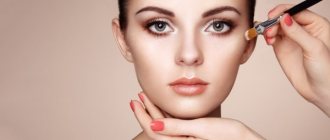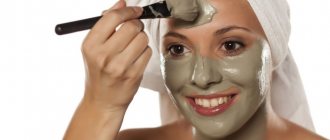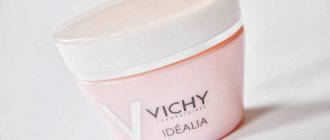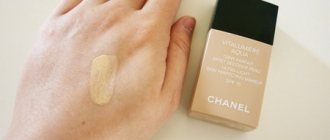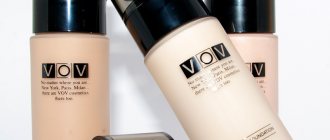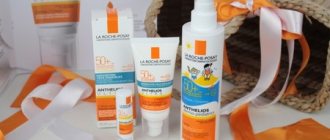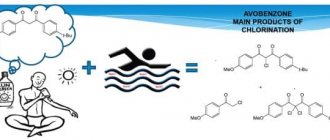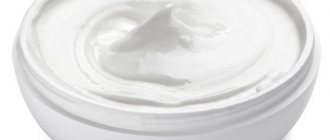Issues discussed in the material:
- How to Apply Sunscreen by Zone
- How to apply sunscreen with makeup
- What mistakes can you make when applying sunscreen?
Today, many people associate sunscreen exclusively with beach holidays. It's no secret that neglecting Sanskrin in the first days threatens with the painful consequences of getting burned for the rest of your vacation. However, dermatologists say that the skin needs protection from ultraviolet radiation at any time of the year. Even 15 minutes of exposure to open sun can damage the skin. You will learn how to apply sunscreen correctly from our article.
Why do you need sunscreen?
At any time of the year, especially people with white skin prone to irritation, need to use sunscreen for the face.
They perform the following functions:
- Protect the skin from intense exposure to ultraviolet rays of both natural and artificial origin.
- Allows you to avoid burns, pigmentation, moles and malignant neoplasms during tanning.
- Contain vitamins and minerals that prevent the appearance of wrinkles and skin aging.
- Sunscreens under makeup maintain the water balance of cells.
How to choose the right one
Reliable sun protection involves the use of high-quality cream.
When choosing a sunscreen, you need to consider the following nuances:
- For the winter period, when there is low solar activity, a sunscreen with an SPF factor of 5 to 15 will be sufficient.
- For summer, you need to choose creams with an SPF factor of 50 to 100.
- For snow-white skin prone to irritation, it is recommended to choose hypoallergenic creams.
- For sunbathing, you need to choose sunscreens that not only protect the skin from ultraviolet radiation, but also contain microelements to maintain the firmness and elasticity of tissues.
Technique for applying sunscreen to face
How to properly apply sunscreen to your face?
Correct application technique:
- The face has very delicate and sensitive skin that needs careful care. Do not rub or stretch the skin too much. Apply any cosmetics only along the massage lines with smooth movements.
- Sunscreen cosmetics that contain physical filters are not completely absorbed into the skin. It forms a transparent protective film against ultraviolet radiation. Such creams should not be applied until completely absorbed.
- The cream should be applied only with your fingertips, using smooth movements.
- Applying cosmetics along massage lines will improve blood circulation and activate the synthesis of natural collagen and elastin, which are necessary to maintain the firmness and elasticity of tissues.
- For better absorption of the cream, you can use patting movements with your palms.
- You need to start from the central part of the face and gradually move to the sides from bottom to top.
- After applying the cream, you need to wait 20 minutes and only then go out into the sun.
- Sunscreen is recommended to be applied to clean skin, even in cloudy weather.
In order to ensure reliable skin protection from ultraviolet radiation, you need to follow simple rules:
- Before applying the cream, be sure to cleanse the skin of dirt and decorative cosmetics.
- Sunscreens with physical filters should be applied on top of day cream, and with chemical filters, on the contrary, before cosmetics.
- In order for the cream to be evenly absorbed and form a protective film on the skin, it must be applied a few minutes before going out into the sun.
- Sunscreens should be applied to clean skin after each contact with water or every 1.5 hours.
- After the beach or the street, you need to wash your face using special products.
- We apply creams with vitamins and minerals to dry skin to restore the epidermis after ultraviolet exposure.
- Be sure to follow the manufacturer's instructions on the packaging.
Also interesting: Sunscreen spf 100, composition, how to choose
SPF in the big city: 27 key questions for experts about daily sun protection
Content
It is impossible to stay at home in this weather. Especially when restrictions have already been lifted. Therefore, a topical update: dermatocosmetologist Victoria Britko ( @dr.viktoria_13
) and Candidate of Medical Sciences Kirill Masliev (
@drmasliev
) talked about whether it is necessary to apply cream under clothes, why it is recommended to remove products with SPF at night, and whether foundations with a UV factor clog pores.
Victoria Britko
Dermatocosmetologist
Should I wear sunscreen under my clothes?
Products with UV filters should be applied only to exposed areas of the skin - face, arms, legs. Ultraviolet rays do not penetrate under clothing, even if it is a very thin fabric.
How to correctly calculate the permissible time spent in the sun?
In order to calculate the required SPF, you need to know your erythema time at a given temperature in given weather conditions. This figure must be multiplied by the one indicated on the packaging of the protective product. This gives you the time you can spend in the sun before erythema (redness) or burns appear.
For example, at a temperature of 30 degrees, the erythema time of a girl with fair skin and blue eyes is about 10 minutes. Accordingly, with SPF 50 protection, she can spend 500 minutes in the sun (10x50SPF=500).
Which filter product is better to choose for the city: chemical or physical?
Physical and chemical filters work differently. The former reflect UV radiation, the latter convert solar energy into thermal energy. It’s best when the composition contains both – only then can we talk about full protection (look for the best sunscreens according to a cosmetologist here).
All natural sunscreens are ineffective - their maximum degree of protection does not exceed six.
Do face creams with SPF protection clog pores?
Any foundation clogs pores, even those labeled “non-comedogenic.” The presence or absence of an SPF filter in it does not change the weather. Pores become clogged due to microparticles of pigment - there is no escape from this. Exacerbation of acne in summer is the result of a combination of cream, dust, excess sebum and other contaminants. This is a good breeding ground for pathogenic microorganisms.
In summer, it is better to give preference to light textures and products without oils in the composition. Ideally, it contains components that slightly regulate the activity of the sebaceous glands.
Do I need to use SPF creams every day?
Of course, starting from March. Even if it is cloudy outside, up to 40% of UVA radiation reaches the surface of the earth. Girls with skin phototypes I and II have every chance of getting sunburned.
Which is better to give preference: spray or cream?
It is better to use protection in the form of creams - sprays need to be dosed correctly. Firstly, they lie on the skin in a very thin layer - some areas may remain untreated. Secondly, particles of the product can enter the respiratory tract, causing allergies and other unpleasant consequences.
All products in the form of sprays and aerosols are applied in several layers - one of the main rules.
Is one foundation with SPF enough to protect your skin in the city?
It is enough if you update it regularly throughout the day. In foundation creams, the SPF factor rarely exceeds 30. Considering that for fair-skinned girls, the average erythema time is about 10 minutes, remove the product and reapply it every 4-5 hours. In summer, it is better to give preference to lighter textures of BB and CC creams. I would recommend going to the beach with a clean face, limiting yourself only to protection.
Is it possible to combine the SPF of a face cream with the SPF of powder and foundation?
No. If the day cream has SPF 30, and the powder, for example, has 20, the protection level is 30. There is no need to fold anything. If you apply several products with a UV filter, calculate the permissible time spent in the sun by inserting the number with the highest value into the formula (look for 10 excellent products with SPF no more than 1000 rubles here).
How to properly apply SPF cream to your face?
The cream should be applied along the massage lines with patting movements - there is no need to aggressively rub it in, pressing hard on the skin (this is not an anti-cellulite massage). If you want to provide additional care, first use a serum, gel or any other nourishing product.
How to wash off SPF products?
There are no waterproof products with SPF - they are completely washed off after taking a shower. They are also removed from the face in the usual way in three stages: you will need makeup remover milk, cleansing foam, and toner.
Which UV factor cream is suitable for our climate?
The sun “does not shine equally for everyone”! Its activity depends on the region. In areas located closer to the equator, the rays fall at right angles - their impact is especially dangerous and detrimental to the skin. There you need to use protection higher than what you are used to using (the erythema time is sharply reduced). The ultraviolet index in your region can be easily determined on the website nesgori.ru or using a special application for a smartphone. In Moscow, for example, it is quite low - about three. In Sydney it is very high - ranging from eight to ten. There, during the daytime it is better not to appear in the sun at all, even with maximum SPF protection.
Are there creams for the skin around the eyes with SPF and are they needed in the city?
The periorbital area is very sensitive. It needs special care - some products and masks are generally contraindicated to be applied to it (read the label!) - they can cause irritation and redness. Special creams for the skin around the eyes with SPF factor are very rare. They are not needed if you wear glasses all the time in the city. Shiseido, Medik8 and several other brands have sunscreen for the periorbital area.
How to choose products with SPF depending on your skin type?
In addition to SPF protection, creams may contain caring and moisturizing components: hyaluronic acid, vitamins, and medicinal plant extracts.
Those with oily skin types should avoid mineral and essential oils.
Vaseline, paraffin, oleic, stearic and palmitic acids are prohibited.
Look for anti-inflammatory ingredients in the composition - this is especially important at high temperatures and active sweating: green tea extract, chamomile, aloe.
Dry skin needs hydration 24 hours a day. An excellent helper for her is thermal water. It can be applied throughout the day without restrictions. Oils are not contraindicated for her. For those with dry skin, everything that contains alcohol and dries out is on the “black list”. Useful ingredients: vitamin E, glycerin, hyaluronic acid, shea butter, vitamins.
Is it true that creams with SPF protection should be applied 30 minutes before going out into the sun?
No. SPF starts working immediately! It is quite appropriate to do this on the beach. In the first days of exposure to active sun, it is better to use products with maximum protection. Further SPF can be reduced.
Can I use skincare products with SPF at night?
Skin care products should be used as intended. Those with SPF filters are needed only during the day. The skin should rest at night - there is no need to load it with additional components. In addition, physical filters that create a screen will prevent the care components from reaching their destination. Wash off SPF before going to bed (find the best night creams here).
Important! Monitor your skin's reaction to the SPF cream - if you notice redness or any other reaction, discard it. It is best to conduct an allergy test before use.
Is it true that SPF creams cause vitamin D deficiency?
In our climate, preparations based on vitamin D, which is produced under the influence of UV light, should be taken from September to March, and sometimes in the summer months. Some people are afraid to use creams with SPF, believing that it causes a deficiency of cholecalciferol (vitamin D3). There is not a single study proving that this is actually the case.
Does cream with SPF protect against freckles?
Cosmetologists even have such a concept as “freckle phototype”. On such skin, under the influence of ultraviolet radiation, melanin is actively formed, which is distributed pointwise. No cream can stop this process 100%.
What ingredients should you avoid in SPF products?
Avoid parabens, strong preservatives and fragrances that can cause allergies in protective products. Benzophenone may cause endocrine disruption. Manufacturers of protective products often use retinyl palmitate. Exposure to UV rays can cause pigmentation. Avoid using cosmetics with retinoids during sun exposure.
Can I use body protectant on my face?
The most common mistake! You can’t do this - you’ll pay with rashes and other problems later. Body products have a denser, thicker texture. Their components clog pores and form a simply “impenetrable” film, which disrupts metabolic processes.
Do people with dark skin need to use cream with SPF?
Sunburn and age spots appear less often on dark skin. This does not mean that it does not need to be protected. It is necessary, but the degree of protection may be lower.
Do you need protection from UVB radiation?
There are three types of UV rays: UVA, UVB and UVC. They differ in wavelength and biological activity. 95% of radiation reaching the earth's surface is UVA. And even the clouds are not a hindrance to them. UVA rays penetrate into the deep layers of the skin and increase the number of free radicals, causing photoaging. UVB radiation is almost completely blocked by the ozone layer. At best, the earth's surface reaches 5%. Despite the large amount of energy they contain, they cannot cause harm. It is enough if the cream only has UVA protection.
Do you need to protect your lips and hair from exposure to ultraviolet radiation?
Protecting your lips should be given as much attention as protecting your face. They are also susceptible to the harmful effects of ultraviolet radiation. If you ignore protection, your lips will “say hello” with dryness and microcracks. They have virtually no melanin, which explains their particular vulnerability. Be sure to apply special balms and lipsticks before going out in the sun. Look at the composition - look for vitamins A, E, F, herbal extracts and aloe juice among the ingredients.
Hair also needs protection. When exposed to UV rays, they not only quickly lose color. Ultraviolet light dries out hair, making it dull and brittle. During periods of solar activity, it is better to use special sprays and oils.
Kirill Masliev
Candidate of Medical Sciences
Are chemical and physical facial filters safe?
No UV filter can be considered 100% safe. Even oils with SPF factor clog my pores. But their harmful effects are nothing compared to the damage that UV radiation can cause to the skin. Beauty fears also have trends: today everyone considers milk healthy, but tomorrow they refuse it, blaming it for facial rashes and other “sins.” It's the same with filters. There is no organic sun protection yet. Accept this fact. Another thing is that there are different types of chemical filters - some of them are really unsafe.
Do physical filters provide reliable sun protection?
Let's start with the fact that physical filters cannot be considered 100% safe. They overload the stratum corneum of the skin, disrupt metabolic processes in the dermis, have an irritating effect, and can cause allergies. Physical filters act as a “screen” - it is difficult for them to provide reliable protection. They almost always work in tandem with chemicals that convert UV rays into thermal energy.
What chemical filters to avoid in the composition?
There are several dozen chemical filters, and some are only potentially dangerous - scientists speculate, but do not have the necessary evidence base. There are also those that really deserve to be blacklisted. Benzophenone-3, for example. Recent studies have shown that this substance can enter the bloodstream and negatively affect the endocrine system. In addition, it is a fairly strong allergen. In modern means it is practically not used. And yet, be careful - it is not officially prohibited.
Oxybenzone acts like an estrogen and can cause allergies. This component is found in most products and absorbs ultraviolet radiation really well. But at the same time, it is fraught with the greatest danger.
A study conducted by researchers at the Institute of Pharmacology and Toxicology in Zurich determined its ability to promote the growth of cancer cells. Scientists from the USA have found that it causes mitochondrial stress, which can become one of the causes of aging of the body.
Para-aminobenzic (denoted on labels as PABA) is a filter that is highly irritating to the skin. Octinoxate, like Benzophenone-3, affects hormonal levels.
Retinyl palmitate. This chemical compound is a type of vitamin A. There is nothing criminal so far, but a study conducted by US institutions suggests that retinyl palmitate may accelerate the development of skin tumors, even in the absence of sunlight.
What chemical filters can be considered safe?
I repeat, there are several dozen of them. But there are those to which neither chemists nor dermatologists have any complaints. Real name" –
Bis-Ethylhexyloxyphenol Methoxyphenyl Triazine. This is a stable and safe substance that reliably protects against all types of radiation.
Ecamsule (Mexoryl SX) is a reliable and safe protector against UVA radiation.
Avobenzone does not affect the hormonal system and only acts on the surface of the skin.
Is it true that SPF products contain substances that penetrate the blood? Is it dangerous?
Yes it is. Scientific experiments have long shown that the chemicals contained in the product penetrate into tissues and then enter the bloodstream. Most sunscreens contain hormone-disrupting chemicals that can cause side effects. Read the ingredients carefully to protect yourself from unwanted consequences.
Review of effective sunscreens
Among the best face creams are the following:
- Avon sun cream spf 30. The moisturizing cream contains components that maintain the firmness and elasticity of tissues. A high degree of protection avoids burns and age spots. The cream has a thick consistency, applies evenly and is quickly absorbed, does not leave an oily sheen on the skin, and has a pleasant watermelon aroma.
- Vichy sun protection SPF 50. It has a high degree of protection, which allows it to be used in the summer heat. Contains moisturizing and restorative components that prevent the aging process under ultraviolet exposure. It has a thick consistency and does not leave an oily sheen on the skin. Can be used for sensitive skin prone to irritation.
- Phytomer for face spf 30. The cream has a high degree of ultraviolet protection. It is enough to distribute over the skin to ensure an even tan without burns or pigmentation. Suitable for sensitive skin, contains vitamins and minerals to maintain youthful tissue. It is resistant to moisture, so it is not necessary to apply a new layer after each contact with water.
How to combine sun protection with decorative cosmetics
Sun protection products are completely compatible with makeup. It is important to follow a certain sequence. Then daytime makeup will become irresistible, and the skin will receive full protection.
- Cleanse the skin. Carry out the procedure of washing, wiping with lotion, tonic.
- Apply day care products if necessary. Wait until they are completely absorbed.
- Apply sunscreen in a thin layer.
- After the previous cream has been absorbed, you can begin to tone the skin.
- Complete the makeup by applying powder, blush, and other decorative cosmetics.
Useful tips!
- Toning the face is done only after protecting it from the sun.
- The cream must be applied evenly. A thin layer will reduce the level of protection, while a thick layer will “float” under the influence of high temperatures.
- After applying sunscreen, you should wait a couple of minutes, then continue with makeup.
- Don't wear too much makeup. Multi-layered makeup can “slip” in the heat.
- It is necessary to give the skin a rest. Everyday use of foundation provokes the appearance of age spots.
- Some experts do not recommend using loose cosmetics such as powder or blush in the summer. Preference should be given to foundations with a creamy structure, then during the day you can renew the protection and touch up your makeup.
- When using two products containing SPF, the degree of protection does not increase. This must be kept in mind when combining sunscreen and moisturizer with SPF factor.
Active women have pushed cosmetic companies to develop products that both care and protect, and the addition of pigments makes them tinted. With just one bottle, you can provide yourself with:
- Hydration;
- Protection;
- Toning.
By following simple rules of sun protection, you can prolong your youth, provide complete care, and create perfect makeup.
